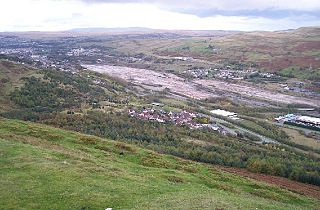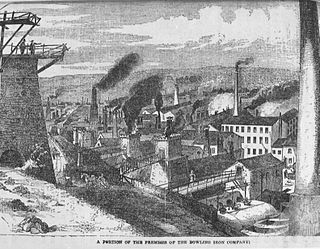British Iron Company (1824-1844)
The company was formed late in 1824 by John Taylor (1779–1863), the mining engineer and entrepreneur. [1] His close associates in the venture were the coppersmith James Henry Shears (who was also associated with him in the Real del Monte Company formed earlier the same year) and Robert Small, a merchant, both of London. The capital which the company proposed to raise was £2,000,000, a high figure, but one which reflected the financial euphoria of the time. There was no lack of subscribers to the undertaking.
The purpose of the company was stated as being to smelt, manufacture and sell iron; to work iron mines; and to purchase ores from other sources as required. During 1825 the company purchased a number of active ironworks or land on which to build. Of these the principal sites were Abersychan in south Wales, Ruabon in north Wales and Corngreaves near Dudley in England. Following the downturn in the economy that set in 1825 the price of iron then fell, funds became tight, and investors who had made an initial payment for shares were either unable or unwilling to meet further calls. The value of shares in the company fell throughout 1825 and 1826 and by the summer of 1826 there was dissatisfaction among the shareholders at the management of the company. It was claimed that properties had been purchased for sums in excess of their true value, that mineral leases had been taken on terms that were burdensome, and that excessive sums of money had been spent on developing these sites. The available evidence points to a lack of financial acumen and practical experience on the part of the managers.
The situation was exacerbated by a pamphlet written by Richard Cort, the son of Henry Cort and cashier of the company until his resignation in February 1826. It protested at the way in which the company's business was being managed, and was critical of the management. [2] Following a number of ill-tempered meetings of the subscribers, Taylor and Shears resigned as directors in October 1826 and a new board was elected. The capital of the company was reduced from £2m to £1m, reducing the liability of the subscribers for further calls. Among the new directors was David Mushet who was also appointed manager. Taylor and Shears, together with Small, continued as trustees of the company's property.
Under the new board the company's prospects improved; even so, over the fifteen years 1826-40 it made a cumulative net profit of only £129,116 on a paid-up capital of £955,205, or 0.09 per cent per annum. [3] It was hampered by heavy royalties and other charges, especially at Abersychan and Corngreaves, from agreements that had been entered into by the company in its formative years. Between 1826 and 1838, also, it was engaged in litigation with the owner of the Corngreaves estate which ultimately went against the company (see below). The suitability of Mushet was questioned at the time of his appointment as managing director in 1826: while he enjoyed a reputation as a metallurgist, Mushet had little practical experience of managing a large ironworks. The company secretary, Harry Scrivenor, a professional ironworks manager, had had little success in this area and is best remembered for his writing. [4] Accusations of incompetent management continued to be made by the shareholders. [5]
Following the adverse judgment given in the Corngreaves case the affairs of the company were thrown into disarray. Its already unhappy position was further exacerbated by the severe recession of the early 1840s. Dissension developed between a faction of shareholders and the directors, with subscribers resisting the payment of further calls on their shares and urging that the company be dissolved in order to release them from future financial liability. After several angry meetings it was finally resolved in September 1841 that the company should be dissolved after the liquidation of all its liabilities. In the meantime operations continued as normal.
Officials and child employees of the British Iron Company were examined by the Royal Commission on Children's Employment of 1841-2 including Richard Wood, manager of Ruabon, William Wood, manager of Abersychan, and other officials at both sites. The report of the commissioners contains much detailed information on working conditions in the company's plants. [6] Employment conditions in the Company's mines in the West Midlands were described in the first report of the Midland Mining Commission of 1843. [7]
| British Iron Company Act 1840 | |
|---|---|
| Act of Parliament | |
 | |
| Long title | An Act for granting certain Powers to the British Iron Company. |
| Citation | 3 & 4 Vict. c. xcvi |
| Dates | |
| Royal assent | 3 July 1840 |
| Text of statute as originally enacted | |












